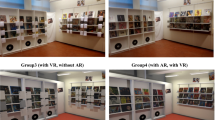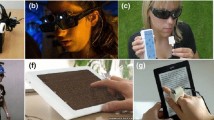Abstract
We consider the challenge of delivering location-based information through rich audio representations of the environment, and the associated opportunities that such an approach offers to support navigation tasks. This challenge is addressed by In-Situ Audio Services, or ISAS, a system intended primarily for use by the blind and visually impaired communities. It employs spatialized audio rendering to convey the relevant content, which may include information about the immediate surroundings, such as restaurants, cultural sites, public transportation locations, and other points of interest. Information is aggregated mostly from online data resources, converted using text-to-speech technology, and “displayed”, either as speech or more abstract audio icons, through a location-aware mobile device or smartphone. This is suitable not only for the specific constraints of the target population, but is equally useful for general mobile users whose visual attention is otherwise occupied with navigation. We designed and conducted an experiment to evaluate two techniques for delivering spatialized audio content to users via interactive auditory maps: the shockwave mode and the radar mode. While neither mode proved to be significantly better than the other, subjects proved competent at navigating the maps using these rendering strategies, and reacted positively to the system, demonstrating that spatial audio can be an effective technique for conveying location-based information. The results of this experiment and its implications to our project are described here.
Similar content being viewed by others
References
Bregman AS (1994) Auditory scene analysis: The perceptual organization of sound. The MIT Press, Cambridge
Brewster SA (1998) Using nonspeech sounds to provide navigation cues. ACM Trans Comput-Hum Interact 5:224–259
Frauenberger C, Putz V, Höldrich R (2004) Spatial auditory displays—a study on the use of virtual audio environments as interfaces for users with visual disabilities. In: DAFx04 proceedings, Naples, Italy, October 5–8 2004. 7th Int. Conference on Digital Audio Effects (DAFx’04), 7th Int. Conference on Digital Audio Effects (DAFx’04)
Hermann T, Ritter H (1999) Listen to your data: Model-based sonification for data analysis. In: Lasker GE (ed) Advances in intelligent computing and multimedia systems, pp 189–194, Baden-Baden, Germany, 08 1999. Int Inst for Advanced Studies in System Research and Cybernetics
Kish D (2003) Sonic echolocation: A modern review and synthesis of the literature. http://www.worldaccessfortheblind.org/sites/default/files/echolocationreview.htm
Morland C, Mountain D (2008) Design of a sonar system for visually impaired humans. In: Proceedings of the 14th international conference on auditory display, Paris, France.
Mountford SJ, Gaver WW (1990) Talking and listening to computers. Addison-Wesley, Massachusetts
Nickerson LV, Stockman T, Thiebaut J (2007) Sonifying the ndon underground real-time-disruption map. In: Scavone GP (ed) Proceedings of the 13th international conference on auditory display (ICAD2007), pp 252–257, Montreal, Canada, 2007. Schulich School of Music, McGill University
Saerberg S (2010) Just go straight ahead” how blind and sighted pedestrians negotiate space. Senses Soc 5(3):364–381
Schafer RM (1977) The Tuning of the World, 1 edn. Random House, New York
Stockman T (2010) Listening to people, objects and interactions. In: Proceedings of ISon 2010, 3rd interactive sonification workshop. KTH Stockholm Sweden, April 2010
Tannen RS (1998) Breaking the sound barrier: designing auditory displays for global usability. In: 4th conference on human factors and the web, Basking Ridge, USA
Walker A, Brewster S (2000) Spatial audio in small screen device displays. Pers Ubiquitous Comput 4:144–154. doi:10.1007/BF01324121
Walker BN, Nance A, Lindsay J (2006) Spearcons: speech-based earcons improve navigation performance in auditory menus. In: Proceedings of the international conference on auditory display, pp 95–98
Yalla P, Walker BN (2008) Advanced auditory menus: design and evaluation of auditory scroll bars. In: Proceedings of the 10th international ACM SIGACCESS conference on computers and accessibility, Assets ’08. ACM, New York, pp 105–112
Zhao H, Plaisant C, Schneiderman B, Duraiswami R (2004) Sonification of geo-referenced data for auditory information seeking: Design principle and pilot study. In: Barrass S, Vickers P (eds) Proceedings of the 10th international conference on auditory display (ICAD2004), Sydney, Australia International Community for Auditory Display (ICAD)
Author information
Authors and Affiliations
Corresponding author
Rights and permissions
About this article
Cite this article
El-Shimy, D., Grond, F., Olmos, A. et al. Eyes-free environmental awareness for navigation. J Multimodal User Interfaces 5, 131–141 (2012). https://doi.org/10.1007/s12193-011-0065-5
Received:
Accepted:
Published:
Issue Date:
DOI: https://doi.org/10.1007/s12193-011-0065-5




